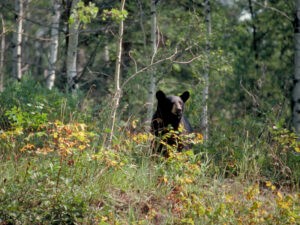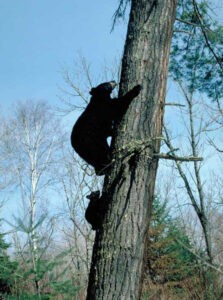PETS.EDU.VN explores the complex question of whether petting a black bear is safe, examining bear behavior and providing guidance on wildlife encounters. Understanding these magnificent animals is crucial for both their safety and yours.
1. Understanding Black Bear Behavior
Black bears (Ursus americanus) are fascinating creatures, often misunderstood. Before considering any interaction, it’s vital to understand their behavior.
1.1. Black Bears: Timid Giants?
Contrary to popular belief, black bears are generally timid animals. Dr. Lynn Rogers, with over 50 years of experience studying these creatures, emphasizes that their aggressive displays are often rooted in fear, not malice. Black bears evolved alongside formidable predators like saber-toothed cats, which led to a “run first, ask questions later” survival strategy. This inherent timidity is a crucial factor in their interactions with humans.
1.2. Decoding Bear “Language”
Bears communicate through a combination of vocalizations, body language, and scent marking. Recognizing these cues is essential for interpreting their intentions. Common signs of nervousness or discomfort include:
- Bluff Charges: Short, rapid advances, often accompanied by huffing or stomping.
- Jaw Popping: A clicking sound made by rapidly opening and closing the mouth.
- Head Bobbing: A jerky, up-and-down movement of the head.
- Raised Hackles: Hair standing up along the back, indicating arousal or fear.
Understanding these signals allows you to assess a bear’s state of mind and react accordingly.
1.3. Defensive vs. Offensive Behavior
It’s crucial to differentiate between defensive and offensive behavior. Defensive behavior is a reaction to perceived threats, such as getting too close to a bear’s cubs or personal space. Offensive behavior, while rare, involves predatory intent.
| Behavior Type | Trigger | Signs | Action |
|---|---|---|---|
| Defensive | Perceived threat to cubs, space, or food source | Hissing, swatting, bluff charges, jaw popping, flattened ears | Slowly back away, avoid direct eye contact, speak in a calm voice, use pepper spray if necessary |
| Offensive | Predatory intent, extreme hunger | Direct stare, stalking, silent approach | Stand your ground, make yourself look large, yell aggressively, fight back with anything available if attacked |



2. The Risks of Petting a Black Bear
While black bears may appear cuddly, attempting to pet one is fraught with danger. Even a seemingly docile bear can react unpredictably.
2.1. Unpredictability of Wild Animals
Wild animals, by nature, are unpredictable. Their behavior is influenced by a multitude of factors, including:
- Individual Temperament: Just like humans, bears have individual personalities. Some may be more tolerant of human presence than others.
- Habituation: Bears that have become habituated to human food sources may be less fearful and more likely to approach people.
- Environmental Stressors: Factors such as food scarcity, competition for resources, or mating season can increase a bear’s stress levels and make it more prone to aggression.
2.2. Potential for Injury
Even if a bear doesn’t intend to harm you, its size and strength can easily cause injury. A swat from a bear’s paw can result in lacerations, fractures, or even death. Black bear claws are strong for climbing trees. While they aren’t sharp for holding prey, they can still do a lot of damage. Teeth are also a potential source of injury. Even a playful nip can break the skin and lead to infection.
2.3. Legal Consequences
In many areas, it is illegal to feed or approach wild animals, including bears. These laws are in place to protect both people and wildlife. Violators may face fines, imprisonment, or both.
3. Safe Bear Encounter Practices
While petting a black bear is never advisable, there are steps you can take to minimize the risk of a negative encounter.
3.1. Maintaining a Safe Distance
The most important rule is to maintain a safe distance. The National Park Service recommends staying at least 100 yards (91 meters) away from bears. This distance allows the bear to feel comfortable and reduces the likelihood of a confrontation. Use binoculars or a telephoto lens to observe bears from afar.
3.2. Making Noise
When hiking in bear country, make noise to alert bears to your presence. This can be achieved by:
- Talking loudly: Carry on conversations with your companions.
- Singing or whistling: Make your presence known through vocalizations.
- Wearing bells: Attach bells to your backpack or clothing to create a constant jingling sound.
Making noise gives bears the opportunity to avoid you, reducing the chance of a surprise encounter.
3.3. Avoiding Food Attractants
Bears have an excellent sense of smell and are attracted to human food. To prevent bears from approaching your campsite or home:
- Store food properly: Use bear-resistant containers or hang food from a tree, at least 10 feet off the ground and 4 feet from the trunk.
- Dispose of garbage properly: Use bear-resistant trash cans or pack out all garbage.
- Clean grills and picnic tables: Remove all food scraps and grease.
- Avoid feeding bears: Never intentionally feed bears, as this can lead to habituation and increase the risk of conflict.
3.4. Understanding Bear Safety Tools and Techniques
Being prepared with the right tools and knowledge is crucial for a safe bear encounter.
- Bear Spray: Carry bear spray and know how to use it.
- Proper Storage: Use bear-resistant containers for food and scented items.
- Awareness: Stay alert and scan your surroundings.
| Tool/Technique | Description | When to Use | How to Use |
|---|---|---|---|
| Bear Spray | A high-concentration pepper spray designed to deter bears. | When a bear approaches aggressively or threatens you. | Remove safety clip, aim down and slightly up, spray in short bursts towards the bear’s face. |
| Food Storage | Containers or methods to keep food and scented items away from bears. | At all times in bear country, whether camping or hiking. | Use bear-resistant canisters, hang food bags at least 10 feet high and 4 feet from a tree trunk, or store food in designated bear-resistant lockers. |
| Awareness | Paying attention to your surroundings and being alert to potential bear activity. | Continuously, especially in areas with dense vegetation or near streams. | Look for signs of bears (tracks, scat, claw marks), listen for sounds, and avoid distractions like headphones. |
| First Aid Kit | Being prepared with essential first aid supplies is crucial for dealing with potential injuries from bear encounters or other wilderness hazards. | Always | Ensure your kit includes antiseptic wipes, bandages, gauze, pain relievers, and any personal medications needed. Know how to treat minor wounds and seek medical help. |
4. What To Do If You Encounter a Black Bear
Even with precautions, bear encounters can happen. Knowing how to react is crucial.
4.1. Staying Calm
The first step is to stay calm. Panicking can escalate the situation. Take a deep breath and assess the bear’s behavior.
4.2. Identifying Yourself
Speak in a calm, firm voice to identify yourself as a human. Wave your arms slowly to make yourself look larger. This can help the bear recognize that you are not prey.
4.3. Avoiding Direct Eye Contact
Avoid direct eye contact, as this can be interpreted as a threat. Instead, focus on the bear’s body language and intentions.
4.4. Slowly Backing Away
If the bear is not behaving aggressively, slowly back away while facing it. Do not turn your back or run, as this can trigger a chase response. Maintain a safe distance and continue to monitor the bear’s behavior.
4.5. Using Bear Spray
If the bear approaches aggressively, use bear spray. Remove the safety clip, aim for the bear’s face, and spray in short bursts. Bear spray is an effective deterrent, but it’s important to use it correctly.
4.6. Fighting Back
If attacked, fight back with anything available. Focus on the bear’s face and eyes. Even if you are injured, fighting back can increase your chances of survival.
4.7. Understanding the “Play Dead” Strategy
Playing dead is generally not recommended for black bear attacks. This strategy is more appropriate for encounters with grizzly bears, which are more likely to attack defensively. If a black bear attacks you, it is generally considered a predatory attack, and fighting back is the best course of action.
5. Dispelling Myths About Black Bears
Many misconceptions surround black bears. Separating fact from fiction is essential for understanding these animals.
5.1. Bears are Always Aggressive
As mentioned earlier, black bears are generally timid animals. Aggression is usually a defensive response to perceived threats.
5.2. Bears “Stalk” Humans
Bears may approach out of curiosity, but this is not necessarily stalking. They are often investigating a smell or sound.
5.3. Bears Attack Because You Are Afraid
Bears do not attack because they sense fear. However, fear can lead to behaviors that provoke an attack, such as running away.
5.4. Climbing Trees is a Safe Escape
While black bears can climb trees, so can you. This strategy is not always effective and may put you in a more vulnerable position.
6. Black Bear Conservation
Black bear populations are generally healthy, but they face ongoing threats, including habitat loss and human-wildlife conflict.
6.1. Supporting Conservation Efforts
You can support black bear conservation by:
- Donating to conservation organizations: Support groups that work to protect bear habitat and reduce human-wildlife conflict.
- Educating others: Share your knowledge about black bears and promote responsible behavior in bear country.
- Advocating for wildlife protection: Support policies that protect bear habitat and promote coexistence between humans and wildlife.
6.2. Responsible Wildlife Viewing
When observing bears in the wild, do so responsibly. Maintain a safe distance, avoid disturbing their natural behavior, and never feed them.
6.3. Reporting Bear Sightings
Report bear sightings to local wildlife agencies. This information can help them track bear populations and manage human-wildlife conflict.
7. Living Safely in Bear Country
If you live in bear country, there are steps you can take to minimize the risk of conflict.
7.1. Securing Your Home
- Install electric fences: Protect gardens, beehives, and livestock with electric fences.
- Remove bird feeders: Bird feeders attract bears, especially during the spring and fall.
- Secure garbage cans: Use bear-resistant garbage cans or store them in a garage or shed.
- Close windows and doors: Keep windows and doors closed, especially when you are not home.
7.2. Managing Your Property
- Clear brush: Remove brush and vegetation around your home to reduce hiding places for bears.
- Pick fruit: Harvest fruit from trees and bushes promptly to prevent bears from being attracted to your property.
- Clean grills: Clean grills regularly to remove food scraps and grease.
7.3. Educating Your Neighbors
Share your knowledge about bear safety with your neighbors. The more people who are aware of the risks and how to prevent conflict, the safer everyone will be.
8. The Importance of Education
Education is key to fostering coexistence between humans and black bears. By understanding bear behavior, implementing safe practices, and dispelling myths, we can minimize the risk of conflict and ensure the long-term survival of these magnificent animals. PETS.EDU.VN is dedicated to providing you with the latest information and resources for responsible pet ownership and wildlife awareness.
9. Black Bears in Popular Culture
Black bears have been featured in numerous books, movies, and television shows, often portrayed as either cuddly creatures or dangerous predators. It’s important to remember that these portrayals are often exaggerated and do not reflect the true nature of black bears.
9.1. Common Stereotypes
- Cuddly Teddy Bears: This stereotype is often perpetuated by children’s books and cartoons. While black bears can be cute, they are wild animals and should never be treated as pets.
- Bloodthirsty Killers: This stereotype is often seen in horror movies and survival stories. While black bears are capable of killing humans, attacks are rare and usually defensive in nature.
9.2. Accurate Portrayals
Some books and documentaries offer more accurate portrayals of black bear behavior and ecology. These resources can help people develop a better understanding of these animals and appreciate their role in the ecosystem.
10. Conclusion: Respecting Black Bears
Can you pet that dog black bear? The answer is a resounding no. While black bears are fascinating animals, they are also wild and unpredictable. Attempting to pet a black bear is dangerous and can have serious consequences. By understanding bear behavior, implementing safe practices, and respecting their space, we can minimize the risk of conflict and ensure the long-term survival of these magnificent creatures.
For more in-depth information on black bears and other animals, visit PETS.EDU.VN. Our website provides comprehensive resources on pet care, wildlife awareness, and conservation efforts.
We at PETS.EDU.VN understand the challenges pet owners and wildlife enthusiasts face in finding reliable information. That’s why we’re dedicated to providing you with the most accurate, up-to-date, and easy-to-understand content. Whether you’re seeking advice on pet nutrition, understanding animal behavior, or finding local pet care services, PETS.EDU.VN is your trusted resource.
Do you have questions about your pet’s health, behavior, or care? Are you looking for a reputable veterinarian, groomer, or pet sitter in your area? Visit PETS.EDU.VN today to explore our extensive library of articles, guides, and resources.
Contact Us:
- Address: 789 Paw Lane, Petville, CA 91234, United States
- WhatsApp: +1 555-987-6543
- Website: PETS.EDU.VN
Frequently Asked Questions (FAQ)
Q1: Is it safe to approach a black bear?
No, it is not safe to approach a black bear. Maintain a distance of at least 100 yards (91 meters).
Q2: What should I do if I encounter a black bear while hiking?
Stay calm, identify yourself as a human, avoid direct eye contact, and slowly back away.
Q3: Is bear spray effective against black bears?
Yes, bear spray is an effective deterrent against black bears.
Q4: Should I play dead if a black bear attacks me?
Playing dead is generally not recommended for black bear attacks. Fight back with anything available.
Q5: Are black bears always aggressive?
No, black bears are generally timid animals. Aggression is usually a defensive response to perceived threats.
Q6: How can I prevent bears from coming onto my property?
Secure your home by installing electric fences, removing bird feeders, securing garbage cans, and closing windows and doors.
Q7: What should I do if a bear enters my home?
Stay calm, make noise to scare the bear away, and call your local wildlife agency.
Q8: Is it illegal to feed bears?
Yes, it is illegal to feed bears in many areas.
Q9: How can I support black bear conservation?
Donate to conservation organizations, educate others, and advocate for wildlife protection.
Q10: Where can I find more information about black bears and pet care?
Visit pets.edu.vn for comprehensive resources on pet care, wildlife awareness, and conservation efforts.
